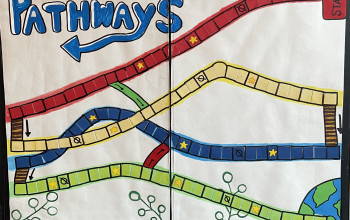
Sample of Pathways game board: Inspired by the RCP (Representative Concentration Pathways), players travel from the worst-case scenario (red path) to the best-case scenario (green path). (Photo by Sophia Powless/ Columbia University)

Sample of Pathways game board: Inspired by the RCP (Representative Concentration Pathways), players travel from the worst-case scenario (red path) to the best-case scenario (green path). (Photo by Sophia Powless/ Columbia University)
A major challenge of climate change communication is showing how our decisions are affecting the world around us. Because it is a global problem it is easy to separate yourself from the issue and ignore it. A large group that is affected by climate change is the younger generation.
What is a way for students to get engaged? Play games with them! Although games are entertaining and seen as a reward, they also contain elements such as collaboration, participation, and critical thinking. Players have to think of strategies and determine which choice will get their character to the goal (or the next save point). The purpose of this game is for players to understand and learn the realities of the climate crisis. Climate change decisions require critical thinking as well as weighing different possibilities. In a game setting, the players are motivated to move forward and are determined to make the right choice.
Therefore, presenting Pathways: the game to show how our actions impact the world around us. It is a decision-based game with players moving away from the worst-case scenario and towards the best-case scenario. The game’s purpose is to show the connections between humans and climate change and understand why the decisions are hard to make. Players will read situations and it is up to them to make the choice that is in the best interest of the planet. To move forward the player needs to consider, “Is this the best pathway?” when answering the decision questions. But some climate decisions are not as explicit as others and some decisions only yield negative or positive outcomes.
In this situation, players will automatically move backward for negative outcomes and forward for a positive outcome. For example, cards that show a decision to burn fossil fuels players automatically move backward.
Although the player moves backward, it does not mean that the game is over. Creating an opportunity to show that even though you can take a setback, there are many opportunities to move forward. This process parallels what is happening in the climate field, there are complications but no matter how many barriers, we need to overcome them for the sake of our communities and our planet.
As for the board design, it needed to illustrate traveling through the board to get to the best-case scenario. What better way than through using the Shared Socioeconomic Pathways (SSP). Adopting this visual provides both a way for students to recognize the SSP chart in the future and comprehend it.
The involvement and engagement of the younger generation are crucial to future climate change decisions. Making topics labeled as “too complex” accessible to the younger generation includes them in the conversation. This game had a trial run in a classroom of fifth-graders and with their feedback; bridges, free spaces, and skip spaces were added. Games spark creativity and collaboration and with the younger generation becoming more involved, interdisciplinary work will be a necessity.